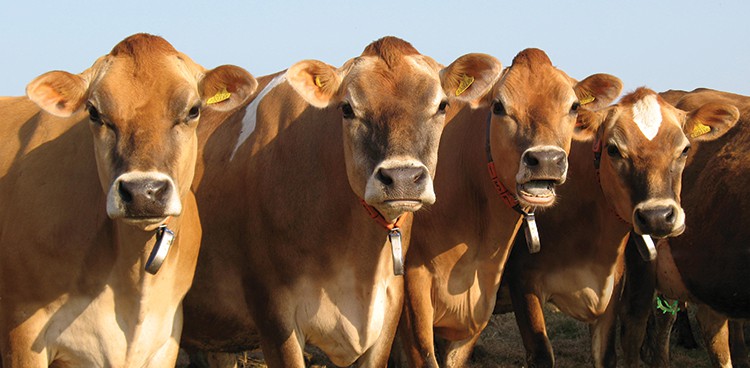
Named for their birthplace—Jersey, the largest island in the English Channel—Jersey cows are thought to be one of the oldest dairy breeds. They first arrived on American soil in 1697, according to the American Jersey Cattle Association (AJCA), but didn’t proliferate until the 1800s. Today there are approximately one million milking Jerseys in the US, and the breed’s adaptability to various climates and landscapes has allowed it to spread successfully across the world from Canada to Japan.
The cow’s relatively small size and milking efficiency makes it an ideal choice for first-time dairy farmers, particularly those interested in totally grass-fed operations. (While some larger breeds require supplemental grain-based feed, Jerseys can thrive solely on grass.) They also reach puberty sooner than most other breeds, and may begin calving at an age younger than average, which means a faster return on farmers’ investments.
Appearance and Temperament
At approximately 48 inches tall and weighing 800 to 1,300 pounds, the Jersey is one of the smallest non-miniature dairy breeds, seen in a range of colors from light tan to almost black. The cows sport light-colored bands around their muzzles, black switches of long hair at the end of their tails, and black hooves. “Stereotypically, they’re very pretty cows,” says Ben Godfrey, owner of Sand Creek Farm in Cameron, Texas. But don’t let their beauty fool you: Though heifers are generally docile, Jersey bulls are notoriously aggressive.
Milk and Cheese
Jerseys are known for producing milk with extremely high butterfat and protein content. On average, the milk is 4.7 percent butterfat and 3.6 percent protein—numbers that work in cheesemakers’ favor, as more milk solids produce more curds per gallon of milk. Godfrey notes that his cows are “good givers,” producing about 27 pounds (three gallons) of milk per cow per day.
In fact, Jerseys can produce up to five gallons of milk a day, a feat for smaller cows. The AJCA calculates that to produce the same amount of milkfat, protein, and other solids as a single Holstein—a popular larger breed—a Jersey cow requires 32 percent less water and 11 percent less land, thus generating a 20 percent smaller carbon footprint.
“Look at how much feed you’re putting into [Jerseys] versus the poundage of milk coming out, and they’re more efficient,” says Jersey fan Mary Falk, proprietor and cheesemaker at LoveTree Farmstead Cheese in Grantsburg, Wis. “They make more money.”
It’s wise to take advantage of Jersey milk’s high butterfat content when making cheese, Falk adds. Her go-to wheels are stinky French Munster (not be confused with mild American muenster). “Munster is so decadent,” she says. “To make it [with] Jersey milk is just to die for.” In Texas, Godfrey uses Jersey milk to produce award-winning gouda as well as soft and semi-soft cheeses such as Brie, Camembert, and mascarpone.



